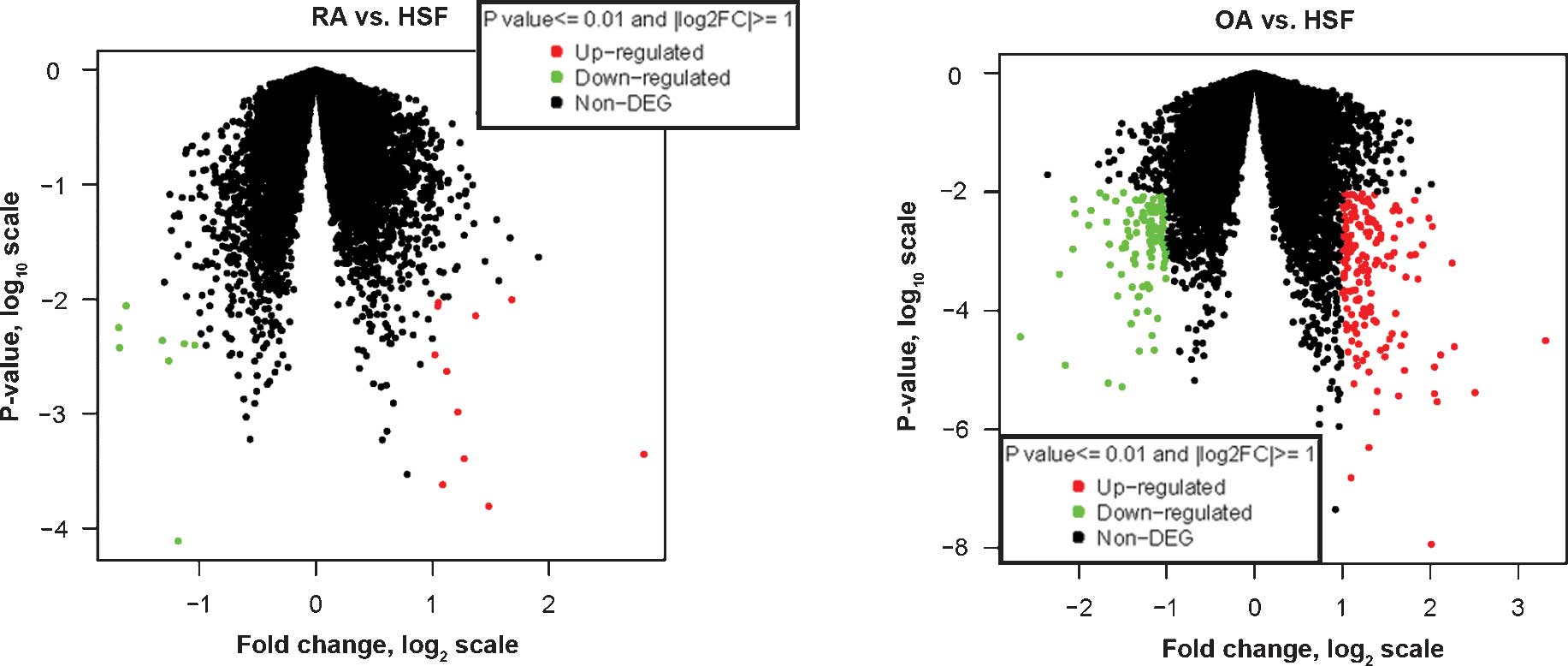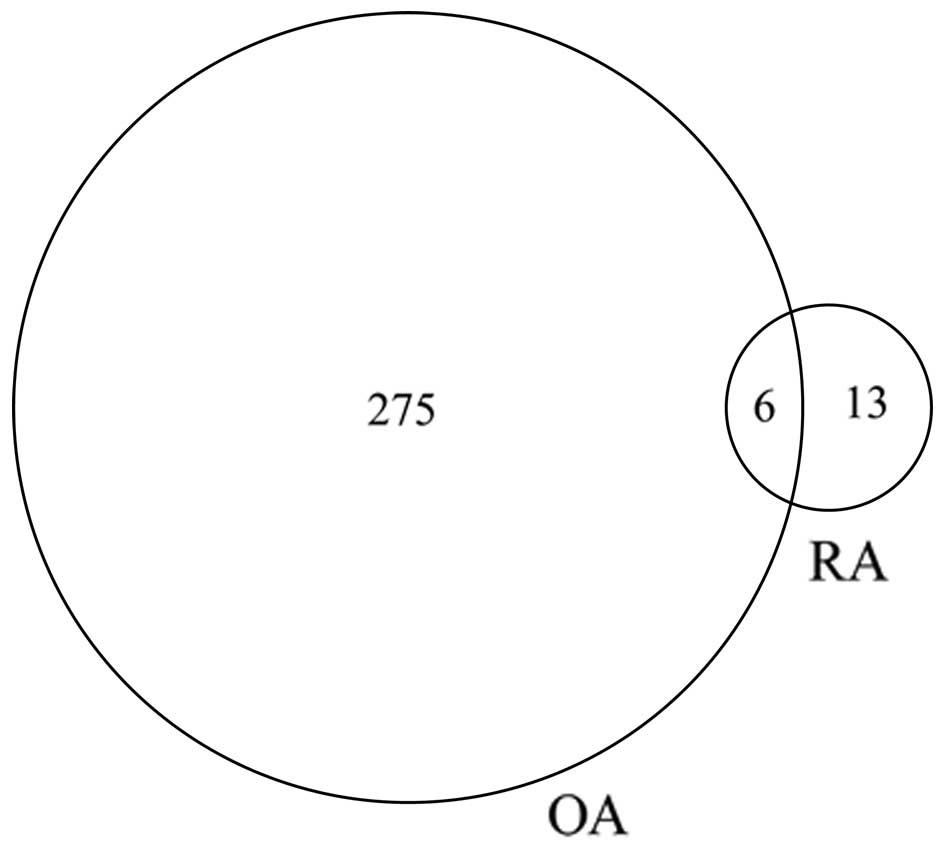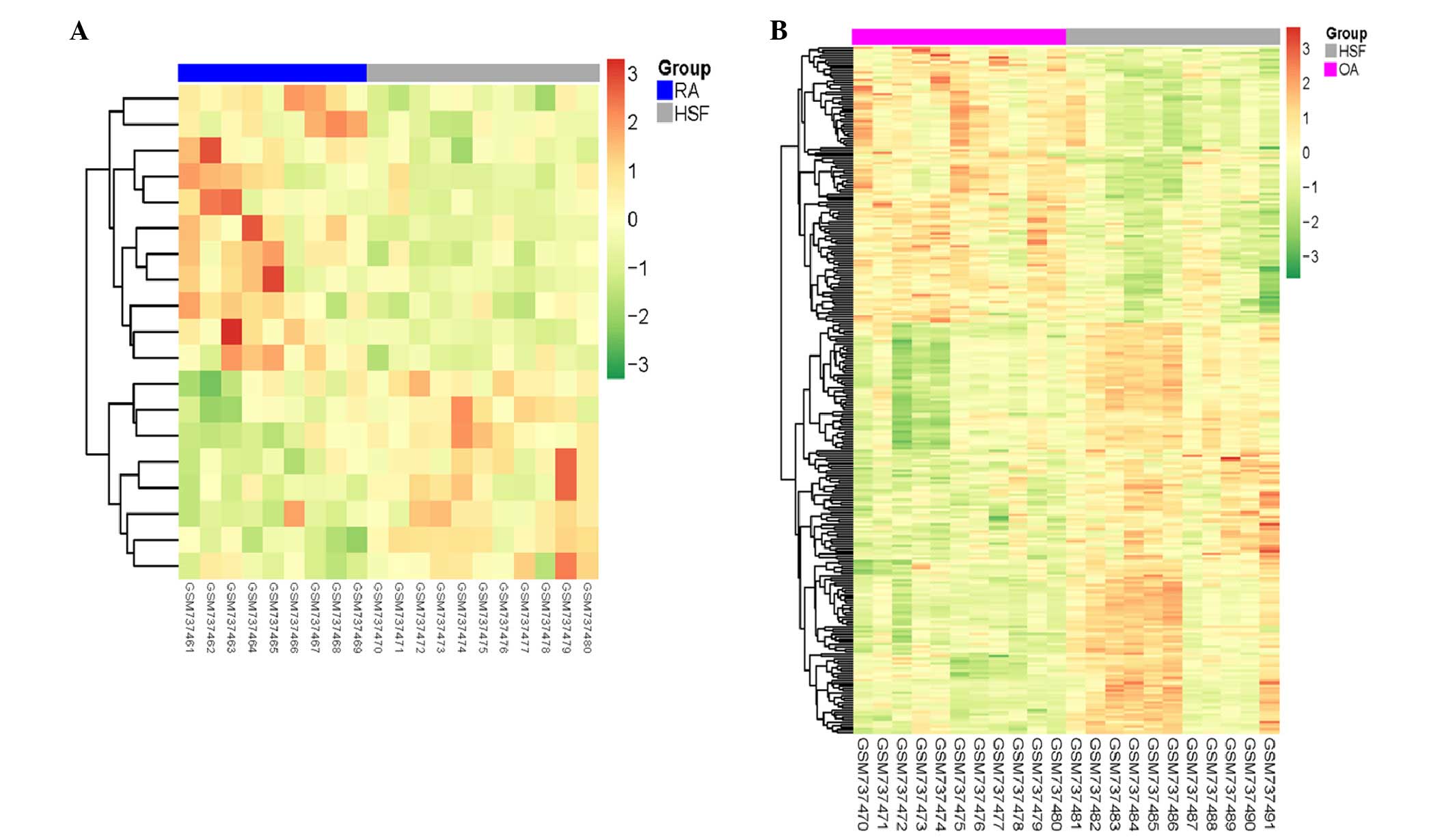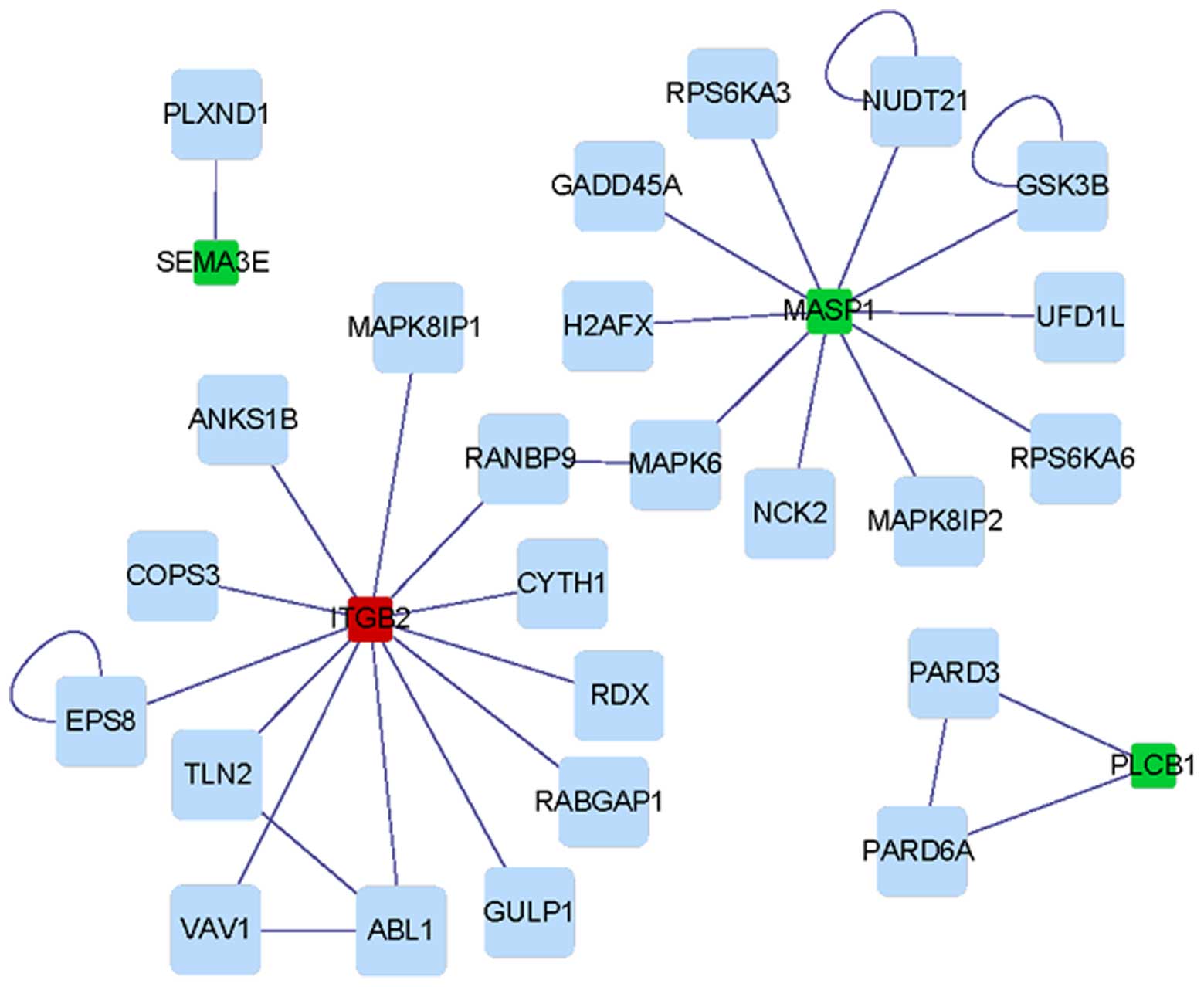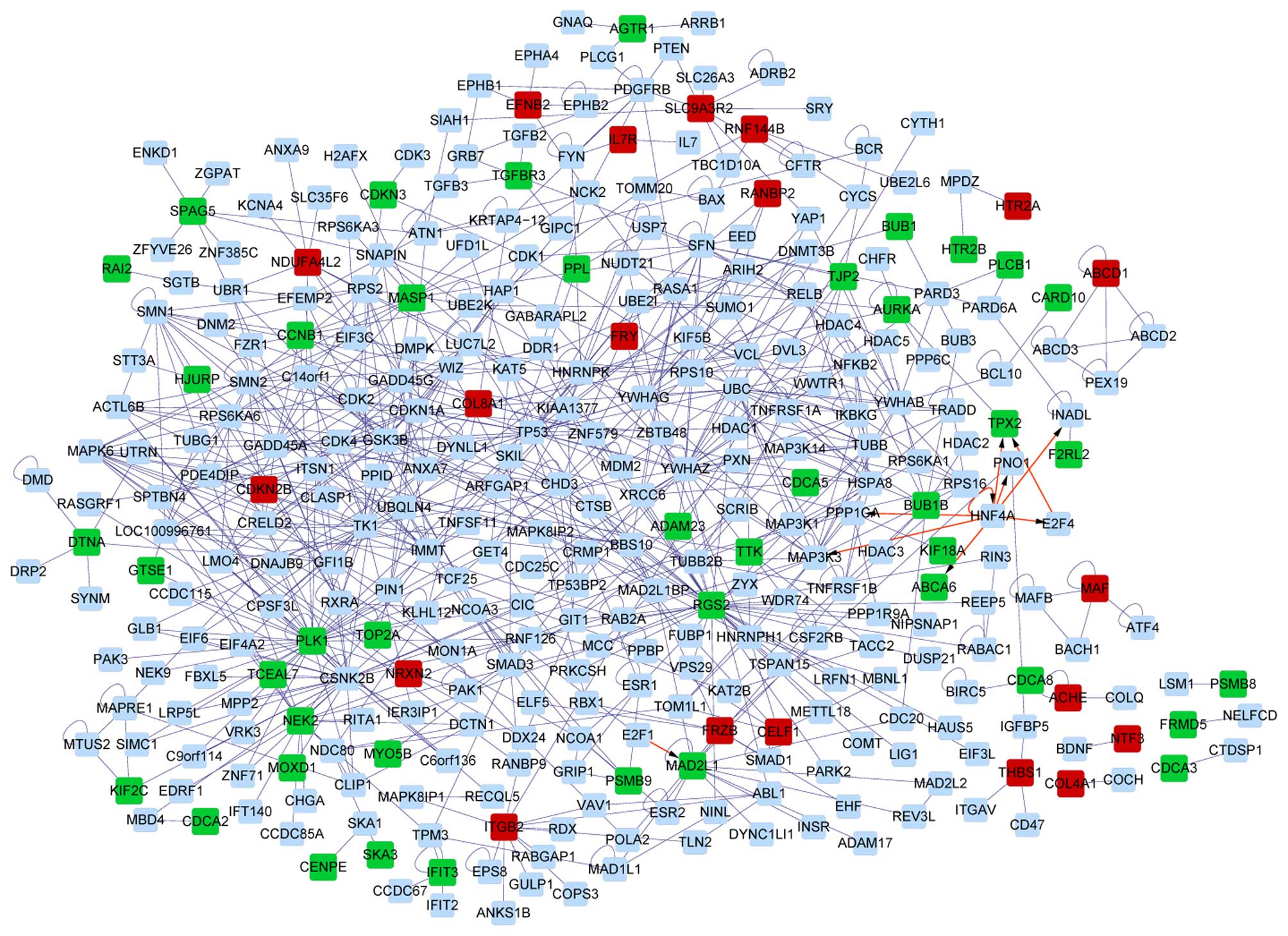Comparison of molecular mechanisms of rheumatoid arthritis and osteoarthritis using gene microarrays
- Authors:
- Published online on: April 15, 2016 https://doi.org/10.3892/mmr.2016.5144
- Pages: 4599-4605
-
Copyright: © Li et al. This is an open access article distributed under the terms of Creative Commons Attribution License.
Abstract
Introduction
Arthritis comprises a variety of diseases with joint pain as a common feature and includes osteoarthritis (OA), rheumatoid arthritis (RA) and psoriatic arthritis, while their underlying mechanisms are divergent (1). OA is a degenerative disease commonly manifesting with mechanical abnormalities of weight-bearing joints and hands, including knees and hips. It is characterized by loss of matrix proteoglycans, fibrillation of cartilage surface and eventual loss of collagenous matrix. Substantial studies have proven that synovial membrane inflammation, abnormal articular chondrocyte differentiation and bone remodeling contribute to the progression of OA (2–4). RA is a systemic autoimmune disease, in which the immune system targets body cells of the same organism. It features chronic inflammation of the synovium and subsequent cartilage destruction as well as bone erosion. The complement system is known to be involved in the induction and progression of inflammatory reactions in RA (5,6).
Synovial fibroblasts (SFs), the most abundant resident cell type in human synovial tissue, are thought to have an important role in the pathogenesis of chronic arthritis (7) and display marked hyperplasia in OA and RA (8). Furthermore, alterations in the expression of various genes have also been observed to be associated with the phenotypic changes in OASFs and RASFs (9,10). Previous microarray studies have confirmed a relatively high heterogeneity of the RASF phenotype (11,12). By comparison between healthy SFs, RASFs and OASFs, Del Rey et al (13) found that OASFs possessed a more homogeneous phenotype compared to RASFs. The present study subjected the microarray data from Del Rey et al (13) to a bioinformatics analysis to identify common and differential molecular mechanisms underlying the two arthritis sub-types. The transcriptional expression profiles of the OASF and RASF samples were compared with those of SFs from healthy controls and key genes were identified.
Materials and methods
Microarray data
Gene microarray dataset GSE29746 was downloaded from Gene Expression Omnibus (http://www.ncbi.nlm.nih.gov/geo/) database (13). The data had been collected from SF cultures obtained from nine patients with RA, 11 age- and gender matched patients with OA, and 11 age- and gender-matched adult healthy donors. The platform was the Agilent-014850 Whole Human Genome Microarray 4×44 K G4112F (Agilent Technologies, Santa Clara, CA, USA).
Microarray data pre-processing
The gene expression profile data were extracted using the Linear Models for Microarray Data (LIMMA) package in R, followed by normexp background correction (14) and subsequent quantile normalization (15). The 95th quantile of all negative controls in each chip was calculated, and only probes with expression values larger than this value in all the samples were retained. According to the annotation platform, the values of probes corresponding to the same transcript were averaged and then defined as the final expression value of a transcript.
Screening of differentially expressed transcripts (DETs)
Volcano plots were drawn to display the differential expression profiles of transcripts for each disease group and the control group. Differential expression analysis of transcripts between the RA group and the control group was performed using the t-test with the LIMMA package, as well as between the OA group and the control group (16). Transcripts with |log2fold change (FC)|>1 and P≤0.01 were screened as DETs. DETs from the two disease groups were compared, and a Venn diagram was used to display the result. A heatmap was also used to exhibit the overall expression profiles of DETs across all samples.
Functional annotation of DETs
The screened DETs were submitted to the online tool Database for Annotation, Visualization and Integrated Discovery (DAVID; http://david.abcc.ncifcrf.gov/summary.jsp) to perform functional annotation based on the gene ontology (GO) database using Fisher's exact test (17).
Analysis of interaction networks of DETs
DETs screened from each disease group were submitted to the Search Tool for the Retrieval of Interacting Genes/Proteins (http://www.stringdb.org/) to construct protein-protein interaction (PPI) networks based on the Biomolecular Interaction Network Database (18). The sub-networks within each network were then detected by clustering analysis using clusterONE (19), and genes involved in each cluster were then subjected to functional enrichment analysis with DAVID (P<0.05 as cut off value).
Results
Screening of differentially expressed transcripts
The differential expression profiles between each disease group and the control group were displayed in Volcano plots (Fig. 1). In total, 19 DETs were screened from the RA group, with |log2FC| values of 1–2.8, among which eight genes were downregulated and 11 genes were upregulated. Furthermore, 281 DETs were screened from the OA group, with |log2FC| values of 1.0–3.3, among which 113 genes were downregulated and 168 were upregulated. As illustrated by the Venn diagram (Fig. 2), the OA group contained a greater number of DETs than the RA group, while the two groups had six DETs in common (Table I). In addition, the heatmaps indicated that the disease samples may be separated from the control samples using the identified DETs (Fig. 3).
Functional annotation of DETs from each disease group
According to functional annotation, DETs from the RA and OA groups were enriched in 8 and 130 GO terms, respectively. Certain DETs from the RA group (e.g. PLCH2, PLCB1, NPTX1 and MASP1) and from the OA group (e.g. F2RL2, PLCB4, PLCH2, PLCB1 and PLCXD1) were commonly enriched in four GO terms, including two molecular function terms associated with phospholipase C activity (Table II). In addition to the four common GO terms, DETs screened from the RA patients were also associated with immune response (e.g. MASP1, IL27RA and ITGB2), while those from the OA group were predominantly associated with the cell cycle and chromosomes, including NEK2, TTK, PTTG2, MAF, CENPN and SGOL2.
Analysis of PPI networks of DETs
The interaction networks of DETs from the RA group and the OA group are shown in Figs. 4 and 5, respectively. It was discovered that the PPI network based on DETs from the OA group was more complex than that of the RA group. The interaction network of the RA group contained one sub-network, while that of the OA group had four sub-networks. DEGs including PSMB9, MAF, HTR2B and HTR2A were the hubs of corresponding PPI sub-networks of DEGs from the OA group, while PLCB1 was a hub of the PPI sub-network of DEGs from the RA group (Table III).
Discussion
The present study revealed that in OA patients, the number of DEGs was higher compared to that in RA patients, which was consistent with the findings of Del Rey et al (13). This previous study identified 2,050 DEGs, several of which were also identified in the screening performed in the present study, such as ITGB2, PIP4K2C and NRXN2, although with different magnitudes of differential expression. Notably, the present study aimed to unravel the mechanisms underlying RA and OA from the perspective of PPI by building PPI networks, the constuction of which was not conducted in the previous study by Del Rey et al (13).
Two DEGs, PLCH2 and PLCB1, screened from the RA patients as well as the OA patients, were enriched in two PLC (phospholipase C) activity-associated GO terms, which may infer that the two arthritis types share certain common mechanisms regarding phospholipase C activity. PLCH2 and PLCB1 encode two members of the phosphoinositide-specific PLC superfamily, PLC-eta 2 and -beta 1, respectively, and PLC catalyzes the hydrolysis of phosphatidylinositol 4,5-bisphosphate into inositol 1,4,5-trisphosphate and 1,2-diacylglycerol) (20). Previous studies have reported a notable elevation of the pro-inflammatory enzyme PLA2 (phospholipase A2), another phospholipase type catalyzing the hydrolysis of membrane glycerophospholipids to release arachidonic acid and lysophospholipids in synovial fluids and sera of RA patients, and its expression has been proven to positively correlate with the disease activity in RA (21,22). Vignon et al (23) observed that PLA2 activity in RA and OA patients was similar, implying that pathological changes mediated by PLA2 are common in RA and OA. However, to the best of our knowledge, PLC activity has not been previously reported in RA or OA. As the two phospholipase types hydrolyze phospholipids at different sites, PLC may presumably also have a role in RA and OA, which requires further experimental validation.
Furthermore, in the present study, two PLC-regulating genes, HTR2B and HTR2A, which encode two members of the 5-hydroxytryptamine 2 receptor family that binds to the neurotransmitter serotonin, were also observed to be specifically differentially expressed in OA patients. These receptors activate PLC to initiate PLC-mediated signal transduction pathways (24). Of note, HTR2A was significantly upregulated, while HTR2B was significantly downregulated, implying their different roles in regulating PLC. The two genes were observed to be enriched in the GO biological process terms phosphoinositide-mediated signaling and second-messenger-mediated signaling as well as in the cellular component term plasma membrane-associated processes. This suggests that alterations in PLC-associated biological functions may be the predominant aberrations in OA patients.
In addition, DEGs screened from OA samples were also specifically and predominantly enriched in GO terms associated with the cell cycle and chromosomes. Among the abundance of DEGs screened from the OA samples, PSMB9 and MAF were the key hubs of the sub-PPI network. PSMB9, which was downregulated in OA, encodes a member of the proteasome B-type family, and proteasomes cleave peptides via an adenosine triphosphate/ubiquitin-dependent pathway. This result was in accordance with previous studies, as the ubiquitin-proteasome pathway has been implicated in the pathogenesis of OA (25), and Rollin et al (26) has reported that PSMB9 is aberrantly expressed in chondrocytes of OA patients. As the present study indicated that PSMB9 was mainly enriched in the GO biological process terms protein metabolic processes and cell cycle, it may be hypothesized that the downregulation of PSMB9 expression induces OA by disturbing normal protein metabolism and the cell cycle. MAF, a homolog of the avian musculoaponeurotic fibrosarcoma oncogene V-Maf, encodes a DNA-binding, leucine zipper-containing transcription factor. The increase in its expression in chondrocytes from patients with OA has been validated by Li et al (27), and it has been suggested that the upregulation of c-MAF expression may alter the phenotype of chondrocytes via regulating corresponding target genes (28), or interacting with other genes associated with chondrogenic differentiation (29). As in the present study, c-MAF was mainly enriched in chromosome-associated GO cellular component terms, it is presumed that it causes abnormal chondrogenic differentiation via inducing chromosomal abnormalities in OA patients.
Compared to those of OA, DETs screened from RA samples were exclusively enriched in immune response-associated GO biological process terms in addition to the four common GO terms, implying that the immune system has a particularly critical role in the occurrence of RA, which is consistent with the fact that RA is a systemic autoimmune disease. MASP1 encodes a serine protease that functions as a component of the lectin pathway of complement activation (30). The upregulation of MASP1 expression, which was also observed by Rioja et al (31), indicated enhanced activation of the lectin pathway as well as the activation of the complement system in RA. Enhanced complement activation has been indicated to be potentially associated with the occurrence and/or augmentation of inflammation in RA (5). Activated synovial fibroblasts and upregulation of the expression of various adhesion molecules that mediate their attachment to the cartilage have been confirmed in rheumatoid arthritis (32). Among these adhesion molecules, the expression of integrin α group proteins, including VLA-3, -4 and -5 has been indicated to increase most significantly (33,34). ITGB2 encodes integrin β2, the expression of which was observed to be upregulated in the present study, which was also reported in RASFs by Del Rey et al (35); it is therefore indicated that ITGB2 is linked with RA.
In conclusion, the present study indicated that genes involved in PLC activity, including PLCH2 and PLCB1, and its regulation, including HTR2A and HTR2B, are aberrantly expressed in RA as well as in OA. Alterations in the expression of genes associated with the cell cycle, including PSMB9 and MAF, were indicated to be linked with OA, while genes participating in the immune response were linked with RA.
References
|
Roivainen A, Söderström KO, Pirilä L, Aro H, Kortekangas P, Merilahti-Palo R, Yli-Jama T, Toivanen A and Toivanen P: Oncoprotein expression in human synovial tissue: An immunohistochemical study of different types of arthritis. Brit J Rheumatol. 35:933–942. 1996. View Article : Google Scholar | |
|
Pullig O, Weseloh G, Ronneberger D, Käkönen SM and Swoboda B: Chondrocyte differentiation in human osteoarthritis: Expression of osteocalcin in normal and osteoarthritic cartilage and bone. Calcif Tissue Int. 67:230–240. 2000. View Article : Google Scholar : PubMed/NCBI | |
|
Drissi H, Zuscik M, Rosier R and O'Keefe R: Transcriptional regulation of chondrocyte maturation: Potential involvement of transcription factors in OA pathogenesis. Mol Aspects Med. 26:169–179. 2005. View Article : Google Scholar : PubMed/NCBI | |
|
Kwon DR and Park GY: Intra-articular injections for the treatment of osteoarthritis: Focus on the clinical use of several regimens. Osteoarthritis-Diagnosis, Treatment and Surgery. Chen Q: InTech; Rijeka: pp. 67–100. 2012 | |
|
Nakagawa K, Sakiyama H, Tsuchida T, Yamaguchi K, Toyoguchi T, Masuda R and Moriya H: Complement C1 s activation in degenerating articular cartilage of rheumatoid arthritis patients: Immunohistochemical studies with an active form specific antibody. Ann Rheum Dis. 58:175–181. 1999. View Article : Google Scholar : PubMed/NCBI | |
|
Chen M, Daha MR and Kallenberg CG: The complement system in systemic autoimmune disease. J Autoimmun. 34:J276–J286. 2010. View Article : Google Scholar | |
|
Bartok B and Firestein GS: Fibroblast-like synoviocytes: Key effector cells in rheumatoid arthritis. Immunol Rev. 233:233–255. 2010. View Article : Google Scholar : PubMed/NCBI | |
|
Izquierdo E, Cañete JD, Celis R, Del Rey MJ, Usategui A, Marsal S, Sanmartí R, Criado G and Pablos JL: Synovial fibroblast hyperplasia in rheumatoid arthritis: Clinicopathologic correlations and partial reversal by anti-tumor necrosis factor therapy. Arthritis Rheum. 63:2575–2583. 2011. View Article : Google Scholar : PubMed/NCBI | |
|
Stanczyk J, Ospelt C, Karouzakis E, Filer A, Raza K, Kolling C, Gay R, Buckley CD, Tak PP, Gay S and Kyburz D: Altered expression of microRNA-203 in rheumatoid arthritis synovial fibroblasts and its role in fibroblast activation. Arthritis Rheum. 63:373–381. 2011. View Article : Google Scholar : PubMed/NCBI | |
|
Karouzakis E, Gay RE, Gay S and Neidhart M: Epigenetic control in rheumatoid arthritis synovial fibroblasts. Nat Rev Rheumatol. 5:266–272. 2009. View Article : Google Scholar : PubMed/NCBI | |
|
Van Baarsen LG, Wijbrandts CA, Timmer TC, Van Der Pouw Kraan TC, Tak PP and Verweij CL: Synovial tissue heterogeneity in rheumatoid arthritis in relation to disease activity and biomarkers in peripheral blood. Arthritis Rheum. 62:1602–1607. 2010. View Article : Google Scholar : PubMed/NCBI | |
|
Kasperkovitz PV, Timmer TC, Smeets TJ, Verbeet NL, Tak PP, van Baarsen LG, Baltus B, Huizinga TW, Pieterman E, Fero M, et al: Fibroblast-like synoviocytes derived from patients with rheumatoid arthritis show the imprint of synovial tissue heterogeneity: Evidence of a link between an increased myofibroblast like phenotype and high-inflammation synovitis. Arthritis Rheum. 52:430–441. 2005. View Article : Google Scholar : PubMed/NCBI | |
|
Del Rey MJ, Usategui A, Izquierdo E, Cañete JD, Blanco FJ, Criado G and Pablos JL: Transcriptome analysis reveals specific changes in osteoarthritis synovial fibroblasts. Ann Rheum Dis. 71:275–280. 2012. View Article : Google Scholar | |
|
Ritchie ME, Silver J, Oshlack A, Holmes M, Diyagama D, Holloway A and Smyth GK: A comparison of background correction methods for two-colour microarrays. Bioinformatics. 23:2700–2707. 2007. View Article : Google Scholar : PubMed/NCBI | |
|
Smyth GK and Speed T: Normalization of cDNA microarray data. Methods. 31:265–273. 2003. View Article : Google Scholar : PubMed/NCBI | |
|
Smyth GK: Limma: Linear models for microarray data. Bioinformatics and computational biology solutions using R and Bioconductor. Gentleman R, Carey VJ, Huber W, Irizarry RA and Dudoit S: Springer; New York: pp. 397–420. 2005, View Article : Google Scholar | |
|
Huang da W, Sherman BT and Lempicki RA: Systematic and integrative analysis of large gene lists using DAVID bioinformatics resources. Nat Protoc. 4:44–57. 2009. View Article : Google Scholar : PubMed/NCBI | |
|
Franceschini A, Szklarczyk D, Frankild S, Kuhn M, Simonovic M, Roth A, Lin J, Minguez P, Bork P, von Mering C and Jensen LJ: STRING v9. 1: Protein-protein interaction networks, with increased coverage and integration. Nucleic Acids Res. 41(Database issue): D808–D815. 2013. View Article : Google Scholar : | |
|
Nepusz T, Yu H and Paccanaro A: Detecting overlapping protein complexes in protein-protein interaction networks. Nat Methods. 9:471–472. 2012. View Article : Google Scholar : PubMed/NCBI | |
|
McLaughlin S, Wang J, Gambhir A and Murray D: PIP(2) and proteins: Interactions, organization, and information flow. Annu Rev Biophys Biomol Struct. 31:151–175. 2002. View Article : Google Scholar : PubMed/NCBI | |
|
Pruzanski W, Keystone EC, Sternby B, Bombardier C, Snow KM and Vadas P: Serum phospholipase A2 correlates with disease activity in rheumatoid arthritis. J Rheumatol. 15:1351–1355. 1988.PubMed/NCBI | |
|
Lin M, Farewell V, Vadas P, Bookman AA, Keystone EC and Pruzanski W: Secretory phospholipase A2 as an index of disease activity in rheumatoid arthritis. Prospective double blind study of 212 patients. J Rheumatol. 23:1162–1166. 1996.PubMed/NCBI | |
|
Vignon E, Balblanc JC, Mathieu P, Louisot P and Richard M: Metalloprotease activity, phospholipase A2 activity and cytokine concentration in osteoarthritis synovial fluids. Osteoarthritis Cartilage. 1:115–120. 1993. View Article : Google Scholar : PubMed/NCBI | |
|
Berg KA, Maayani S and Clarke WP: Interactions between effectors linked to serotonin receptors. Ann NY Acad Sci. 861:111–120. 1998. View Article : Google Scholar | |
|
Jang BC, Sung SH, Park JG, Park JW, Bae JH, Shin DH, Park GY, Han SB and Suh SI: Glucosamine hydrochloride specifically inhibits COX-2 by preventing COX-2 N-glycosylation and by increasing COX-2 protein turnover in a proteasome-dependent manner. J Biol Chem. 282:27622–27632. 2007. View Article : Google Scholar : PubMed/NCBI | |
|
Rollin R, Marco F, Camafeita E, Calvo E, López Durán L, Jover J, López JA and Fernández-Gutiérrez B: Differential proteome of bone marrow mesenchymal stem cells from osteoarthritis patients. Osteoarthritis Cartilage. 16:929–935. 2008. View Article : Google Scholar : PubMed/NCBI | |
|
Li T, Xiao J, Wu Z and Qiu G: Over-expression of c-maf by chondrocytes in osteoarthritis. J Int Med Res. 37:129–135. 2009. View Article : Google Scholar : PubMed/NCBI | |
|
Maclean HE, Kim JI, Glimcher MJ, Wang J, Kronenberg HM and Glimcher LH: Absence of transcription factor c-maf causes abnormal terminal differentiation of hypertrophic chondrocytes during endochondral bone development. Dev Biol. 262:51–63. 2003. View Article : Google Scholar : PubMed/NCBI | |
|
Huang W, Lu N, Eberspaecher H and De Crombrugghe B: A new long form of c-Maf cooperates with Sox9 to activate the type II collagen gene. J Biol Chem. 277:50668–50675. 2002. View Article : Google Scholar : PubMed/NCBI | |
|
Goeldner I, Skare T, Boldt AB, Nass FR, Messias-Reason IJ and Utiyama SR: Association of MASP-2 levels and MASP2 gene polymorphisms with rheumatoid arthritis in patients and their relatives. PLoS One. 9:e909792014. View Article : Google Scholar : PubMed/NCBI | |
|
Rioja I, Clayton CL, Graham SJ, Life PF and Dickson MC: Gene expression profiles in the rat streptococcal cell wall-induced arthritis model identified using microarray analysis. Arthritis Res Ther. 7:R101–R117. 2005. View Article : Google Scholar : PubMed/NCBI | |
|
Nikkari L, Aho H, Yli-Jama T, Larjava H, Jalkanen M and Heino J: Expression of integrin family of cell adhesion receptors in rheumatoid synovium. Alpha 6 integrin subunit in normal and hyperplastic synovial lining cell layer. Am J Pathol. 142:1019–1027. 1993.PubMed/NCBI | |
|
Rinaldi N, Schwarz-Eywill M, Weis D, Leppelmann-Jansen P, Lukoschek M, Keilholz U and Barth TF: Increased expression of integrins on fibroblast-like synoviocytes from rheumatoid arthritis in vitro correlates with enhanced binding to extracellular matrix proteins. Ann Rheum Dis. 56:45–51. 1997. View Article : Google Scholar : PubMed/NCBI | |
|
Ishikawa H, Hirata S, Andoh Y, Kubo H, Nakagawa N, Nishibayashi Y and Mizuno K: An immunohistochemical and immunoelectron microscopic study of adhesion molecules in synovial pannus formation in rheumatoid arthritis. Rheumatol Int. 16:53–60. 1996. View Article : Google Scholar : PubMed/NCBI | |
|
Del Rey MJ, Izquierdo E, Usategui A, Gonzalo E, Blanco FJ, Acquadro F and Pablos JL: The transcriptional response of normal and rheumatoid arthritis synovial fibroblasts to hypoxia. Arthritis Rheum. 62:3584–3594. 2010. View Article : Google Scholar : PubMed/NCBI |



